1 of 12
Download to read offline
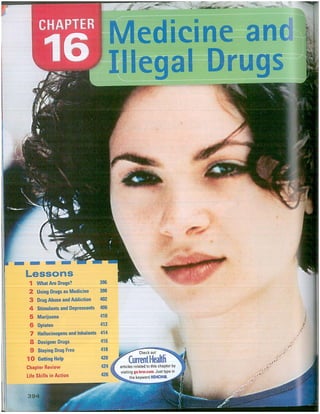
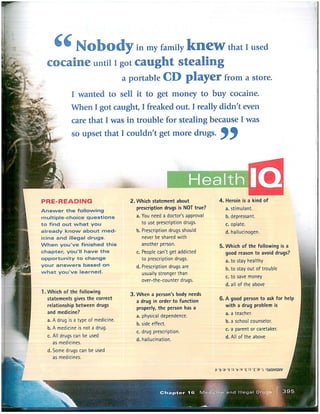
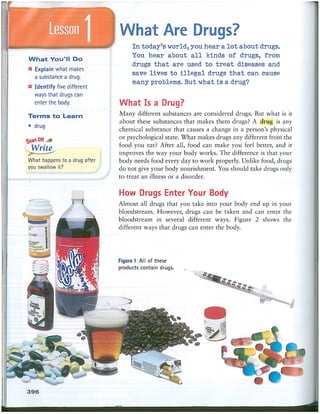
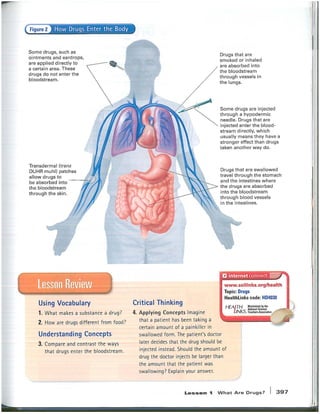
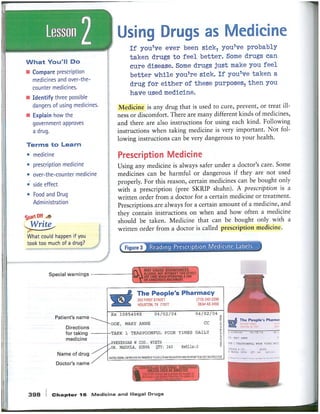
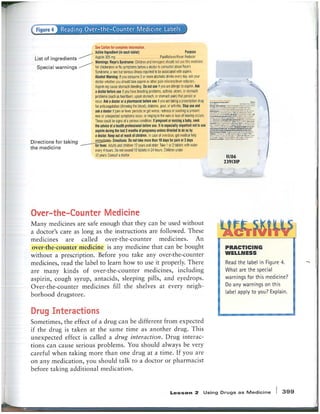
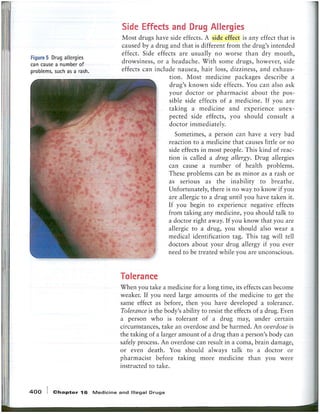
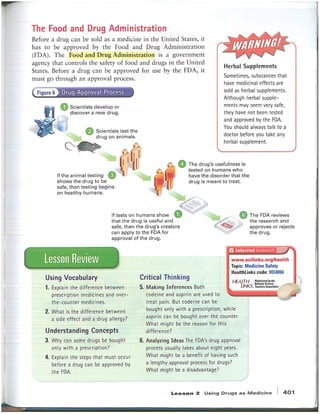
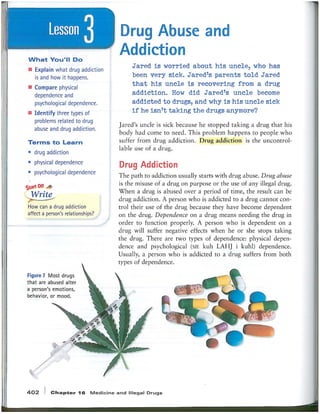
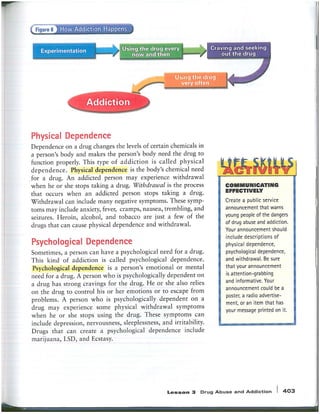
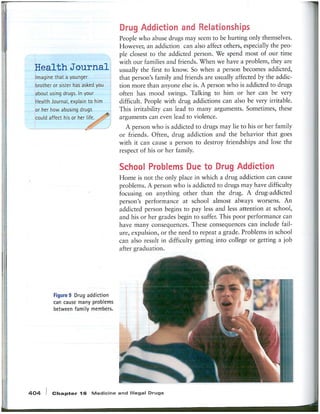

Ad
Recommended
Medicines in my home
Medicines in my homecarlyrelf
Ã˝
The document provides information about proper use and safety of over-the-counter medicines. It discusses what medicines are, how to read labels and directions, potential side effects and warnings. Examples are given of different people's medicine situations and whether their choices were appropriate. The key messages are to read labels carefully, use medicines as directed, and ask doctors or pharmacists with any questions.Smoking pre quiz
Smoking pre quizcarlyrelf
Ã˝
This document contains a pre-quiz for a 7th grade tobacco chapter with 11 true/false questions. The questions cover topics like the health risks of different tobacco products, nicotine being a drug, the illegality of selling to minors, addiction, methods and effects of quitting, and the impacts of secondhand smoke. The purpose is to test students' understanding of the chapter material on the dangers and impacts of tobacco use.Smoking and tobacco use
Smoking and tobacco usecarlyrelf
Ã˝
Smoking and tobacco use contains over 60 toxic chemicals that are harmful and in some cases fatal to human health. Smoking kills over 1,000 Americans per day from smoking-related illnesses like cancer, heart disease, and lung disease. While tobacco companies advertise their products as cool and attractive, the reality is that long-term smoking takes years off people's lives and causes premature death and disease. It is important for youth to understand the true health risks and impacts of smoking so they can make informed choices to stay smoke-free.New advertising techniques
New advertising techniquesVillanuevam
Ã˝
This document outlines several common advertising techniques used to promote products:
1) Diversion uses emotional distractions to draw attention away from important issues.
2) Plain Folks suggests products are for ordinary people.
3) Snob Appeal implies using a product makes one part of an elite, luxurious lifestyle.
4) Testimonial uses famous personalities to endorse products.
5) Simple Solutions presents products as solving multiple problems with one purchase.Smoking and tobacco use
Smoking and tobacco useHardemanr
Ã˝
Smoking and tobacco use can have serious negative health consequences:
- More than 1,000 Americans die each day from smoking-related illnesses. Tobacco is toxic, addictive, and can kill users by taking away years of their lives.
- Cigarettes contain over 7,000 chemicals, many of which are toxic, including carbon monoxide, formaldehyde, arsenic, cyanide, and over 70 cancer-causing agents.
- Both smoking and exposure to secondhand smoke increase risks of cancer, heart disease, lung disease, premature birth, and infant death. Quitting smoking can reduce health risks.Hiv aids
Hiv aids carlyrelf
Ã˝
- HIV/AIDS is a serious, deadly disease that has infected over 70 million people globally since being identified in the 1980s. Currently, there are over 34 million people living with HIV worldwide.
- HIV weakens the immune system by destroying important immune cells called CD4 cells. If untreated, HIV can develop into AIDS, leaving the body vulnerable to infections and diseases. While antiretroviral drugs can suppress HIV and prolong life, there is currently no cure for HIV/AIDS.
- HIV is transmitted through bodily fluids like blood, semen, vaginal fluids, and breast milk. Common routes of transmission include unprotected sex and sharing needles. Casual contact like hugging, kissing, or mosquito bitesHealthy menu rubric
Healthy menu rubriccarlyrelf
Ã˝
The document provides requirements and rubrics for students to design a 2-3 day healthy eating menu plan for a teenager based on their age, gender, activity level, and foods available in their school cafeteria. The plan must include breakfast, lunch, dinner, and 2 snacks per day listing details of meals including serving sizes. Using the food pyramid as a guide, students must show the recommended amounts from each food group. The menu should include a variety of colorful, appealing, and healthy options avoiding high fat or sugar items. Students will be assessed on their knowledge of healthy choices, explanation of serving sizes and food groups, creating a balanced menu according to food pyramid guidelines, and consideration of other diet choices.Anxiety disorders
Anxiety disorderscarlyrelf
Ã˝
The document discusses various anxiety disorders including generalized anxiety disorder, social anxiety, phobias, and panic disorder. It provides an overview of each disorder and includes a bibliography of sources on the topics. The author explores solutions to anxiety issues and their reasons for choosing this issue to research.Dyslexia health buzz sydney
Dyslexia health buzz sydneycarlyrelf
Ã˝
This document discusses dyslexia, including what it is, how it affects teenagers, and potential solutions. It explores dyslexia through different sections such as causes and effects, challenges faced by teens, and approaches to help overcome dyslexia. The document concludes by explaining why dyslexia was chosen as the topic and providing a bibliography in MLA format with sources on dyslexia facts, symptoms, famous people with dyslexia, and definitions of dyslexia.Schizophrenia razel
Schizophrenia razelcarlyrelf
Ã˝
Schizophrenia is a chronic mental disorder that causes abnormal thinking, perceptions, emotions, language, and behavior. Early signs include delusions, hallucinations, and disorganized speech or behavior. Chronic signs involve negative symptoms like reduced emotional expression and apathy. The causes are unknown but likely involve a combination of genetic and environmental factors. There are different types of schizophrenia defined by their symptoms.Grade 8 wellness open house
Grade 8 wellness open house carlyrelf
Ã˝
The document outlines a grade 8 wellness course that covers four types of well-being: physical, emotional, mental, and social. It examines the relationship between responsibility, sound decision-making, and good health. The course consists of four units that cover topics like physical fitness, nutrition, substance abuse, and sexual health. It also provides information on assessment and examples of student work.Relf advisory slideshow open house presentation
Relf advisory slideshow open house presentationcarlyrelf
Ã˝
The document provides information about advisory class, including that it is meant to build relationships, teach life skills, and provide a small supportive community within a larger school. It discusses the goals of advisory to support self-awareness, sense of belonging, and fun, as well as cultivate caring, ethical, self-directed, creative, balanced, and responsible dispositions. Examples of advisory activities are given such as visual similes and a counting challenge.Anti drugbookletrubric
Anti drugbookletrubriccarlyrelf
Ã˝
The document provides instructions for students to create an anti-drug booklet about alcohol and marijuana. It outlines requirements for the booklet's content including detailed descriptions of each drug, their effects, decision-making strategies, and refusal skills. Students are to conduct research using the Big6 research steps and present their findings in the booklet. They will be assessed based on their demonstration of knowledge, use of evidence, and understanding of decision-making skills.Depression misconceptionvsrealityrubric
Depression misconceptionvsrealityrubriccarlyrelf
Ã˝
This document outlines the requirements and rubric for an assignment where students in an 8th grade mental health unit will create a poster about misconceptions and realities of depression. The poster must describe one misconception and explain the truth using at least 5 facts, statistics, and 3 quotes from research. It should communicate understanding of the topic creatively through visual design and concepts. The teacher will assess students based on transfer of learning, detail, explanation, critical thinking, communication, originality, and use of visuals.Mental illness
Mental illnesscarlyrelf
Ã˝
One in six people has a mental illness. Mental illnesses are caused by imbalances in brain chemicals that affect thoughts, feelings, and behaviors. They can be triggered by genetic and environmental factors. Common mental illnesses include anxiety disorders like panic attacks, phobias, and obsessive compulsive disorder (OCD), mood disorders like depression and bipolar disorder, and schizophrenia, which causes a break from reality.Language examples
Language examplescarlyrelf
Ã˝
This document provides lists of persuasive and emotive language that can be used when writing arguments. It separates language into positive and negative categories, and also provides vocabulary for comparing and contrasting ideas, explaining concepts, indicating cause and effect, and concluding arguments. The document acts as a reference for students to draw from to strengthen their persuasive writing skills.Anti Drug Booklet 201415
Anti Drug Booklet 201415carlyrelf
Ã˝
The document provides instructions for students to create an anti-drug booklet about alcohol and marijuana. It outlines the content requirements including researching 6 questions each about the drugs' effects on the mind and body, explanations of terms like blood alcohol concentration and gateway drugs, and descriptions of decision making and refusal skills. Students are to follow research steps including defining tasks, seeking credible information, citing sources, and self-evaluating their work. The booklet will be graded based on demonstrated knowledge, use of evidence, creativity, and communication skills.Depression misconceptionvsreality1 7handoutandrubric
Depression misconceptionvsreality1 7handoutandrubriccarlyrelf
Ã˝
This document outlines an assignment for an 8th grade mental health unit on depression. Students were asked to create an informational poster highlighting a common misconception about depression and the reality. The poster should include facts from provided materials and research, as well as quotes. Rubrics are provided to assess students on transfer of knowledge, detail, critical thinking, communication skills, originality, and learning habits. Students were also asked to complete a written reflection on what they learned about depression and how they can apply it going forward.Mental illness
Mental illnesscarlyrelf
Ã˝
One in six people have a mental illness. Mental illnesses are disorders that affect thoughts, feelings, and actions which are controlled by the brain. They can be caused by imbalances in brain chemistry and are influenced by both genetic and environmental factors. Common mental illnesses include anxiety disorders like panic attacks, phobias, and OCD, mood disorders like depression and bipolar disorder, and schizophrenia, which causes a break from reality.Obesity
Obesitycarlyrelf
Ã˝
Obesity is defined as an excessive amount of body fat, measured by BMI over 30 or waist circumference over 35 inches for women or 40 inches for men. It can be caused by lack of exercise, unhealthy diet, genetics, quitting smoking, age, and pregnancy. Risks of obesity include heart disease, various cancers, stroke, diabetes, and social and cardiovascular problems for adolescents. Prevention focuses on regular exercise, healthy eating, avoiding unhealthy foods, weight monitoring, and consistency.Bipolar
Bipolarcarlyrelf
Ã˝
Bipolar disorder is a brain disorder characterized by extreme mood swings between mania and depression that can last for long periods of time. There are three main types - Bipolar I involves alternating periods of mania and depression, Bipolar II involves hypomania and depression, and Cyclothymia involves milder periods of hypomania and depression. Genetics and brain structure/functioning contribute to the development of bipolar disorder. Symptoms include feeling very happy or depressed, changes in energy levels and concentration. The author's father and some family members have been diagnosed with cyclothymia or Bipolar I/II.Gaming Addiction
Gaming Addictioncarlyrelf
Ã˝
Video game addiction is defined as playing video games excessively to an unhealthy degree, most commonly among those aged 10-18. Games are designed to be addictive by fulfilling human psychological needs easily and providing escapism. Consequences of addiction include chronic back pain, neglecting family and friends, migraines, and long term sleeping problems. While 12% of gamers showed signs of addiction in 2009, addiction can be avoided by moderating play time and prioritizing school and family over games.Eating disorders A time in the life 2014
Eating disorders A time in the life 2014carlyrelf
Ã˝
The document outlines requirements for an 8th grade assignment on eating disorders. Students must create a fictional character suffering from anorexia, bulimia, or binge eating and include their friends/family. They must present information on the disorder's signs, health impacts, treatments, and advice on healthy eating/weight control. Students will be evaluated on accurately conveying this content through a creative media project utilizing IT displaying visual aids, and citing reliable sources in MLA format. Recommended websites provide information on eating disorders to help students complete the assignment.Danger of fast food rubric
Danger of fast food rubriccarlyrelf
Ã˝
The document outlines the criteria and rubric for assessing a student project on the dangers of fast food. Students will create a movie to demonstrate their understanding of how personal health choices can affect risk of disease. They will be evaluated on their comprehension of the topic, ability to effectively communicate health risks to an audience through storytelling, and proper sourcing of information.Well 7 course requirements (201415)
Well 7 course requirements (201415)carlyrelf
Ã˝
This document outlines the Grade 7 Wellness course which focuses on physical, emotional, mental, and social well-being. The course covers four units: healthy body and fitness, respect and relationships, substance abuse, and sexual health. Students will complete assignments such as fitness flyers, videos on fast food dangers, comics on conflict resolution, and presentations on media messages. Assessment is based on knowledge and understanding, skill transfer, and communication through tests, quizzes, and projects. Ground rules emphasize respecting others and maintaining confidentiality.More Related Content
More from carlyrelf (20)
Hiv aids
Hiv aids carlyrelf
Ã˝
- HIV/AIDS is a serious, deadly disease that has infected over 70 million people globally since being identified in the 1980s. Currently, there are over 34 million people living with HIV worldwide.
- HIV weakens the immune system by destroying important immune cells called CD4 cells. If untreated, HIV can develop into AIDS, leaving the body vulnerable to infections and diseases. While antiretroviral drugs can suppress HIV and prolong life, there is currently no cure for HIV/AIDS.
- HIV is transmitted through bodily fluids like blood, semen, vaginal fluids, and breast milk. Common routes of transmission include unprotected sex and sharing needles. Casual contact like hugging, kissing, or mosquito bitesHealthy menu rubric
Healthy menu rubriccarlyrelf
Ã˝
The document provides requirements and rubrics for students to design a 2-3 day healthy eating menu plan for a teenager based on their age, gender, activity level, and foods available in their school cafeteria. The plan must include breakfast, lunch, dinner, and 2 snacks per day listing details of meals including serving sizes. Using the food pyramid as a guide, students must show the recommended amounts from each food group. The menu should include a variety of colorful, appealing, and healthy options avoiding high fat or sugar items. Students will be assessed on their knowledge of healthy choices, explanation of serving sizes and food groups, creating a balanced menu according to food pyramid guidelines, and consideration of other diet choices.Anxiety disorders
Anxiety disorderscarlyrelf
Ã˝
The document discusses various anxiety disorders including generalized anxiety disorder, social anxiety, phobias, and panic disorder. It provides an overview of each disorder and includes a bibliography of sources on the topics. The author explores solutions to anxiety issues and their reasons for choosing this issue to research.Dyslexia health buzz sydney
Dyslexia health buzz sydneycarlyrelf
Ã˝
This document discusses dyslexia, including what it is, how it affects teenagers, and potential solutions. It explores dyslexia through different sections such as causes and effects, challenges faced by teens, and approaches to help overcome dyslexia. The document concludes by explaining why dyslexia was chosen as the topic and providing a bibliography in MLA format with sources on dyslexia facts, symptoms, famous people with dyslexia, and definitions of dyslexia.Schizophrenia razel
Schizophrenia razelcarlyrelf
Ã˝
Schizophrenia is a chronic mental disorder that causes abnormal thinking, perceptions, emotions, language, and behavior. Early signs include delusions, hallucinations, and disorganized speech or behavior. Chronic signs involve negative symptoms like reduced emotional expression and apathy. The causes are unknown but likely involve a combination of genetic and environmental factors. There are different types of schizophrenia defined by their symptoms.Grade 8 wellness open house
Grade 8 wellness open house carlyrelf
Ã˝
The document outlines a grade 8 wellness course that covers four types of well-being: physical, emotional, mental, and social. It examines the relationship between responsibility, sound decision-making, and good health. The course consists of four units that cover topics like physical fitness, nutrition, substance abuse, and sexual health. It also provides information on assessment and examples of student work.Relf advisory slideshow open house presentation
Relf advisory slideshow open house presentationcarlyrelf
Ã˝
The document provides information about advisory class, including that it is meant to build relationships, teach life skills, and provide a small supportive community within a larger school. It discusses the goals of advisory to support self-awareness, sense of belonging, and fun, as well as cultivate caring, ethical, self-directed, creative, balanced, and responsible dispositions. Examples of advisory activities are given such as visual similes and a counting challenge.Anti drugbookletrubric
Anti drugbookletrubriccarlyrelf
Ã˝
The document provides instructions for students to create an anti-drug booklet about alcohol and marijuana. It outlines requirements for the booklet's content including detailed descriptions of each drug, their effects, decision-making strategies, and refusal skills. Students are to conduct research using the Big6 research steps and present their findings in the booklet. They will be assessed based on their demonstration of knowledge, use of evidence, and understanding of decision-making skills.Depression misconceptionvsrealityrubric
Depression misconceptionvsrealityrubriccarlyrelf
Ã˝
This document outlines the requirements and rubric for an assignment where students in an 8th grade mental health unit will create a poster about misconceptions and realities of depression. The poster must describe one misconception and explain the truth using at least 5 facts, statistics, and 3 quotes from research. It should communicate understanding of the topic creatively through visual design and concepts. The teacher will assess students based on transfer of learning, detail, explanation, critical thinking, communication, originality, and use of visuals.Mental illness
Mental illnesscarlyrelf
Ã˝
One in six people has a mental illness. Mental illnesses are caused by imbalances in brain chemicals that affect thoughts, feelings, and behaviors. They can be triggered by genetic and environmental factors. Common mental illnesses include anxiety disorders like panic attacks, phobias, and obsessive compulsive disorder (OCD), mood disorders like depression and bipolar disorder, and schizophrenia, which causes a break from reality.Language examples
Language examplescarlyrelf
Ã˝
This document provides lists of persuasive and emotive language that can be used when writing arguments. It separates language into positive and negative categories, and also provides vocabulary for comparing and contrasting ideas, explaining concepts, indicating cause and effect, and concluding arguments. The document acts as a reference for students to draw from to strengthen their persuasive writing skills.Anti Drug Booklet 201415
Anti Drug Booklet 201415carlyrelf
Ã˝
The document provides instructions for students to create an anti-drug booklet about alcohol and marijuana. It outlines the content requirements including researching 6 questions each about the drugs' effects on the mind and body, explanations of terms like blood alcohol concentration and gateway drugs, and descriptions of decision making and refusal skills. Students are to follow research steps including defining tasks, seeking credible information, citing sources, and self-evaluating their work. The booklet will be graded based on demonstrated knowledge, use of evidence, creativity, and communication skills.Depression misconceptionvsreality1 7handoutandrubric
Depression misconceptionvsreality1 7handoutandrubriccarlyrelf
Ã˝
This document outlines an assignment for an 8th grade mental health unit on depression. Students were asked to create an informational poster highlighting a common misconception about depression and the reality. The poster should include facts from provided materials and research, as well as quotes. Rubrics are provided to assess students on transfer of knowledge, detail, critical thinking, communication skills, originality, and learning habits. Students were also asked to complete a written reflection on what they learned about depression and how they can apply it going forward.Mental illness
Mental illnesscarlyrelf
Ã˝
One in six people have a mental illness. Mental illnesses are disorders that affect thoughts, feelings, and actions which are controlled by the brain. They can be caused by imbalances in brain chemistry and are influenced by both genetic and environmental factors. Common mental illnesses include anxiety disorders like panic attacks, phobias, and OCD, mood disorders like depression and bipolar disorder, and schizophrenia, which causes a break from reality.Obesity
Obesitycarlyrelf
Ã˝
Obesity is defined as an excessive amount of body fat, measured by BMI over 30 or waist circumference over 35 inches for women or 40 inches for men. It can be caused by lack of exercise, unhealthy diet, genetics, quitting smoking, age, and pregnancy. Risks of obesity include heart disease, various cancers, stroke, diabetes, and social and cardiovascular problems for adolescents. Prevention focuses on regular exercise, healthy eating, avoiding unhealthy foods, weight monitoring, and consistency.Bipolar
Bipolarcarlyrelf
Ã˝
Bipolar disorder is a brain disorder characterized by extreme mood swings between mania and depression that can last for long periods of time. There are three main types - Bipolar I involves alternating periods of mania and depression, Bipolar II involves hypomania and depression, and Cyclothymia involves milder periods of hypomania and depression. Genetics and brain structure/functioning contribute to the development of bipolar disorder. Symptoms include feeling very happy or depressed, changes in energy levels and concentration. The author's father and some family members have been diagnosed with cyclothymia or Bipolar I/II.Gaming Addiction
Gaming Addictioncarlyrelf
Ã˝
Video game addiction is defined as playing video games excessively to an unhealthy degree, most commonly among those aged 10-18. Games are designed to be addictive by fulfilling human psychological needs easily and providing escapism. Consequences of addiction include chronic back pain, neglecting family and friends, migraines, and long term sleeping problems. While 12% of gamers showed signs of addiction in 2009, addiction can be avoided by moderating play time and prioritizing school and family over games.Eating disorders A time in the life 2014
Eating disorders A time in the life 2014carlyrelf
Ã˝
The document outlines requirements for an 8th grade assignment on eating disorders. Students must create a fictional character suffering from anorexia, bulimia, or binge eating and include their friends/family. They must present information on the disorder's signs, health impacts, treatments, and advice on healthy eating/weight control. Students will be evaluated on accurately conveying this content through a creative media project utilizing IT displaying visual aids, and citing reliable sources in MLA format. Recommended websites provide information on eating disorders to help students complete the assignment.Danger of fast food rubric
Danger of fast food rubriccarlyrelf
Ã˝
The document outlines the criteria and rubric for assessing a student project on the dangers of fast food. Students will create a movie to demonstrate their understanding of how personal health choices can affect risk of disease. They will be evaluated on their comprehension of the topic, ability to effectively communicate health risks to an audience through storytelling, and proper sourcing of information.Well 7 course requirements (201415)
Well 7 course requirements (201415)carlyrelf
Ã˝
This document outlines the Grade 7 Wellness course which focuses on physical, emotional, mental, and social well-being. The course covers four units: healthy body and fitness, respect and relationships, substance abuse, and sexual health. Students will complete assignments such as fitness flyers, videos on fast food dangers, comics on conflict resolution, and presentations on media messages. Assessment is based on knowledge and understanding, skill transfer, and communication through tests, quizzes, and projects. Ground rules emphasize respecting others and maintaining confidentiality.